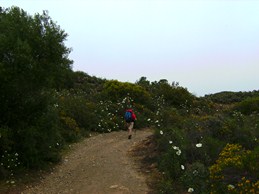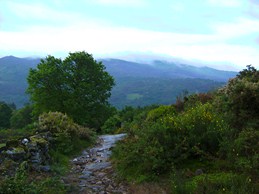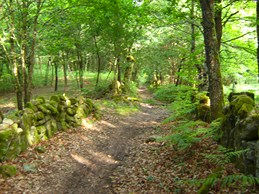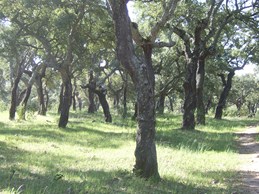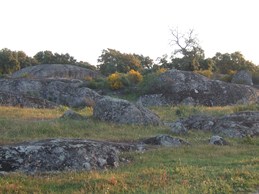(24 June 2011)
I’d like to tell you about something which has dominated my life in the past months, naturally in relation to psychoanalysis. In April and May I have walked, on my own, the Camino de la Plata, in Spain. The walk went from Sevilla to Santiago de Compostella, a distance of 1000 kilometres. Initially I was going to walk with a friend, but there were circumstances of which the end result was, that he wasn’t going, and so: I went on my own. The alternative would have been: not going.
Going to make this trip on the one hand fascinated me, on the other hand it made me kind of anxious and insecure, especially because this time I was going to go alone. Before it started, I was occupied with it. In that period, it was about expectations, and not so much about actual facts. Fear, insecurity and anxiety were the basic themes in the period before I left. I was afraid to get lost and having to wander. I also feared that physically I would not be able to walk the distance, and I dreaded the mental confrontation. I wondered if, both mentally and physically, I wasn’t too vulnerable to be able to accomplish this journey on my own.
So the thought, to walk the Camino on my own, at the same time attracted and scared me. The anxious doubt was large, but I had made my decision: the fear did not make me reconsider my decision. I considered whether I should practice in order to be able to complete the walk. But then again: how do you practice a walk of a 1000 kilometres, day in, day out, and this 40 days? In fact, I was unable to imagine what this meant: 1000 kilometres was too much, too long to create an image of it in my head. I came no further than that it was long and far, like a child can have the experience of 1,2,3…. a lot; more than 3 no longer has an emotional meaning, it is overwhelming for the child. So it was with me and the distance of 1000 kilometres, and so it goes at the start of a long term psychoanalytic treatment.
It seemed as if the intended walk activated, on the one hand, a great deal of very basic feelings centred around fear, safety and insecurity, and self esteem (??) from an early period in my life. On the other hand, I wondered whether I wasn’t using the Camino as a transitional space, to prepare for a new phase in my life. I had done something like it before, when, at the end of my secondary school, a went into a monastery, where I stayed a number of years to prepare myself, from there, for adult life.
 When I was home again, after the walk, during the first night, I dreamt about the trip. This was accompanied by sleep-walking. In the middle of the night, I stood in front of the doors in the bedroom that go into the garden. I had to get out, but I couldn’t; I was looking for a road-sign which I couldn’t find. I had a slightly panicky feeling of having lost the way. My wife helped me by turning ont the light and showing me where I was: back home. I calmed down and went back to bed. She was the relevant, reassuring Other and the representative of the reality principle. In the days after that, I went on dreaming, but now without the sleepwalking. My dreams were always about the walk, in my dreams I repeated, as it were, parts of my trip, very concrete, but always from a constellation in which I was, in the dream, both the walker and the observer of the walker. I kept an eye on myself in the dream.
When I was home again, after the walk, during the first night, I dreamt about the trip. This was accompanied by sleep-walking. In the middle of the night, I stood in front of the doors in the bedroom that go into the garden. I had to get out, but I couldn’t; I was looking for a road-sign which I couldn’t find. I had a slightly panicky feeling of having lost the way. My wife helped me by turning ont the light and showing me where I was: back home. I calmed down and went back to bed. She was the relevant, reassuring Other and the representative of the reality principle. In the days after that, I went on dreaming, but now without the sleepwalking. My dreams were always about the walk, in my dreams I repeated, as it were, parts of my trip, very concrete, but always from a constellation in which I was, in the dream, both the walker and the observer of the walker. I kept an eye on myself in the dream.
My wife said, jokingly, that it seemed as if I wanted to leave again, to walk again. But she was wrong: I don’t think it was about a wish or a longing, in my dreams. No, it was much more a way to give the experience of the Camino a place in my inner life. Wiederholen und Durcharbeiten, that was what it was about. Dreams, not as wish-fulfilment, but as a mental way of working through.
At first, when I was back home, I missed the routine, the rituals and the setting of the Camino. The leaving very early in the morning, when it was still dark, in order not to have to walk in the heat. Checking your rucksack every morning to see everything was still there. Did I have enough water and bread, a piece of sausage or cheese, an apple, some black chocolate. Following the yellow arrows, walking in a sort of automatic movement en organising a bed for the evening after arriving. After that, a shower, taking care of legs and feet, doing some laundry, and then a nap and writing in my diary. And keeping check on who arrived and who didn’t, all this, I missed. For the first time, my legs hurt, I was kicking the habit and this, also, I knew, from my own analysis and from analysing my patients.
During my trip, I felt connected to the people walking the same path. I didn’t really know them, and yet I felt connection of a kind: you belong together and this in itself creates a connection. In the beginning, it was less about the people themselves, much more about the connection that was there because you walked the same path.
The albergue is the place where the digestion takes place, the working through of what has happened during the walk of that day. Walking was very basic and primary, the secondary process was there but very much in the background; the doing, the walking came first, thinking and reflecting came later, in the albergue, lying in bed.
In the beginning of the walk, I lived in a very specific time perspective. I had started a 1000 kilometre walk, having no real image of what this was, 1000 kilometres, it was just unimaginably long. It was like the horizon disappeared, and there was nothing but the here and now. The walk didn’t stand in a time perspective of yesterday, today and tomorrow; there was just the walking. Past, present and future didn’t have any meaning; that only came when we had passed Ourense and there were about 200 kilometres more to go. Then, suddenly, the end of the walk was on the horizon, the perspective changed, there was room for life after the Camino. With this, much changed. I noticed that I started planning again: what to do when I arrived in Santiago, how to organise the trip back; was I going by train or plane, how would I say goodbye to the people I had been walking with these past few weeks, what would it be like after each had gone his or her own way. There was room, again, for ‘layers’; the secondary process became dominant. I noticed that, from a certain moment, I was saying goodbye. This is not a specific choice you make: you suddenly realize that you’re saying goodbye to the Camino and to the people you’re walking with.
I also realized that I had become attached to people that I didn’t really know, that I had incidentally met. Some of them came and went, others were there longer, some you lost and missed, others left because of injuries, or were out of sight because they walked faster, or slower, than you. Always, it was about connecting and disconnecting, about finding an adequate balance between following your own road and adjusting to others. But it was also about finding the right balance of what you can and cannot bear, about finding and guarding your limits. Taking care of yourself, listening to your body so as not to collapse by straining it too much. This process, too, which in the beginning took place very momentaneous, and later within an obvious time perspective, I recognized from my own analysis and from my patients.
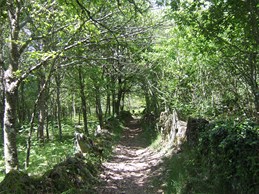
The first two weeks of the Camino it was hot, between 30 – 35 degrees. And with a weight of 11 kilos on your back, this is very hot. I walked alone and this made me alert; I kept a sharp eye for the yellow arrows, so characteristic for the pilgrim road of the Camino. Pretty soon I noticed that I fell into a sort of automatic movement, a kind of monotonous rhythm; like my legs controlled and steered the walking, and as if I followed my legs, instead of the other way round. I also noticed that my body and my rucksack needed time to adjust to each other. In the beginning, that rucksack was alien and unfamiliar to my body, with which my shoulders and my hips had difficulties at first, but slowly they adjusted to each other and my rucksack became a part of me. It was a good, familiar feeling to put it back on, early each morning.
On top of this, I noticed something totally different, namely, that all kinds of fantasies rose in me. It seemed, as if I used those to make the heat and the being-alone manageable. Fantasies, to keep the head cool and to regulate feelings of fear. I noticed that fantasising works: it comforts and makes life bearable.
At some moment, lying in my bunk bed in the safety of the albergue, I realised that I was actually always fantasising. And, in my fantasies, there was always somebody walking with me, who kept an eye on me and who commented on what I was doing. I realised that my fantasies went according to the same pattern: that I was seen, and, in a kind way, was kept an eye on, that there was someone watching over me, guarding me. It made me think of Fairbairn who, years ago, said that the inner life of people represents their particular pathology. I realised that my way of fantasising not only went according to a steady pattern, but that also my way of looking at myself and others became clear in it.
These characteristic fantasies, in their turn, woke up a number of very specific memories from various periods in my life and, with that, connected to extensive networks with changing emotional colours. Fragments of grief mingled with missing, with longing and with realising that things are as they are, and though the past cannot be changed, the memories can change in colour. I felt acceptance and more calm, I noticed that I started to walk straighter, and I started to look around me, to other pilgrims but also to the things of nature, the world around me became more clear and I myself had more space in it.
What happened was, that I traced an important aspect of my inner working model, and I realised how this inner working model was made, and what I had needed it for, and why. At the same time, I noticed that I, because of this, more freedom to reflect on it, en felt less determined by it. This is exactly what happens in a psychoanalytic process: the attachment system is activated, and the inner working models are detected and provoked, in order to be able to adjust it where necessary.
After two weeks, the weather changed, it became cooler but not only that; it also started to rain. The paths changed into slippery rivulets of mud, the profile of my shoes filled up en it was hard to keep a grip on where I was walking. It became even more basic and unnerving, you could say exciting, and from time to time I felt unsafe. When walking through herds of horses with their foal, or cows and their calves, and Iberian black pigs and their piglets, I realised I had to keep track of which foal belonged to which horse, which cow to which calf, or which Iberian black pig to which piglet. If you don’t, you will be confronted with attachment behaviour, which, really, you rather wouldn’t.  What I also noticed, was that fantasising no longer worked: I was too pressurised or nervous to be able to. I was mostly occupied with surviving, with keeping grip with the road and not to slip, with crossing brooks by jumping from stone to stone – and these stones were mostly not nicely laid for easy jumps – and with walking through the various cattle herds with my skin intact.
What I also noticed, was that fantasising no longer worked: I was too pressurised or nervous to be able to. I was mostly occupied with surviving, with keeping grip with the road and not to slip, with crossing brooks by jumping from stone to stone – and these stones were mostly not nicely laid for easy jumps – and with walking through the various cattle herds with my skin intact.
I only realised these things afterwards, in the albergue, resting on my bed. I realised that, to be able to fantasise, you need a certain emotional space, which, because of the rain and its consequences, was lacking now. I also realised that apparently I used my fantasies not only to avoid loneliness, but also to feel safe and to regulate my feelings of anxiety and fear; and how comforting these fantasies were and how much I was attached to them. But I also began to understand that reflecting about this can only take place if there is a measure of peace and safety. If this is lacking, “doing” and the “behaviour” will dominate and survival is what it is about. The quality of life is of lesser importance: the physical and concrete reality takes the place of the mental.
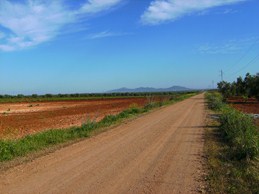
At some point, I was walking through some brushwood when, at my right, I heard a strange kind of moaning cry, of which I couldn’t discover the origin. I found that I had all kinds of thoughts in my head about what this cry could mean, but at the same time, there was something that actively pushed these thoughts away, which made it possible for me to walk on, relatively calm. In the evening, in a small village restaurant, I told this to the woman serving us, who laughed and left and came back with a picture of her husband with a friend, who had shot three wolves, two days ago. She laughingly pointed at me, and said “Lobo, Lobo” (which Is Spanish for Wolf , my last name).
At that moment, I experienced a feeling of terror. When she noticed this, she tried to reassure me by saying that I didn’t have to be afraid, because wolves are afraid of wolves, except when they have no food and are hungry. But this reassurance didn’t work. What I later realised was that repression doesn’t only work unconsciously but also consciously, and can be uncommonly efficient if it concerns avoiding fear.
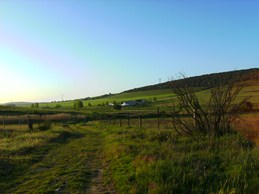
When the path ascended very steeply or descended sharply, and I would only get ahead with difficulty, I noticed that I got the idea that ‘the path’ was playing a game with me, like the path was walking ahead of me and challenged me to follow it. It made me angry, of course I knew that this was nonsense, that ‘the path’ did not have intentions, but still it felt that way and my intellectual ‘knowing’ this did not have any consequences for how I felt about this, I blamed the path for this and that, and especially for the fact that it behaved so ruthlessly and did not take me into account. If, after a while of not seeing the yellow arrow, I finally spotted it again, it would give me a feeling of safety, I felt a connection with it, it gave me a sense of security. You could say I had a relationship with the path and with the arrows. The same would go for when, in the morning, I would hear the call of the cuckoo: like the cuckoo was walking along with me and called to me especially. Of course I knew very well that it would be different cuckoos every day, but still, it felt as if one cuckoo walked with me and called to me. Also, seeing the same people again on the same path would evoke happy feelings in me, of familiarity, of ‘all is well’.
 I noticed that it became more important to me which people did and which didn’t arrive, who collapsed and who remained standing (or walking); I felt kind of proud that I was one of the ones who remained standing. I felt increasingly involved with the others, but didn’t lose my sense of self because of this. Others gained significance for me, but I also realised that I gained significance for others. I would worry if one of the people I walked with, wasn’t at the albergue in the evening. To others, again, I would want to prove that I was as good as they were in walking, I wanted to keep up with them, feelings of rivalry, jealousy, vindictiveness etcetera increasingly played a role and how. I realized that I liked some people and actively sought their company, while there were others that I didn’t like and avoided. Increasingly, there were specific people that I felt a connection with, and connectedness as such was no longer enough. I realised that the need for connectedness as such had changed into the need for connection with specific people.
I noticed that it became more important to me which people did and which didn’t arrive, who collapsed and who remained standing (or walking); I felt kind of proud that I was one of the ones who remained standing. I felt increasingly involved with the others, but didn’t lose my sense of self because of this. Others gained significance for me, but I also realised that I gained significance for others. I would worry if one of the people I walked with, wasn’t at the albergue in the evening. To others, again, I would want to prove that I was as good as they were in walking, I wanted to keep up with them, feelings of rivalry, jealousy, vindictiveness etcetera increasingly played a role and how. I realized that I liked some people and actively sought their company, while there were others that I didn’t like and avoided. Increasingly, there were specific people that I felt a connection with, and connectedness as such was no longer enough. I realised that the need for connectedness as such had changed into the need for connection with specific people.
Once arrived in Santiago, I took my leave of the people I had walked with for the last couple of days. While walking through the town I kept meeting people I had met during the walk and had lost contact with for whatever reason. I gave me a good feeling to see them, to embrace them and to talk about how they and I had fared, and then to walk on again. Eventually, I sat at a terrace. With a beer in my hand I reviewed the whole walk in my mind. I noticed that I couldn’t hold on to the walk in the actual way I had walked it, but I didn’t mind this. I found that what settled in me was the ‘experience’, with the people I had met and whom I took with me, inside. Not the people as separate objects, but the connection that I had with them, this was what I took with me, inside, back to Amsterdam. This is what we mean when we talk about the process of mental representation.
Naturally, what I experienced during the Camino is not the same as what goes on in a long term psychoanalytic treatment, but in some respect, there are similarities. What it is about in psychoanalytic treatment, is to go on a journey and eventually, to come back home; this quest goes according to a certain process, as the Camino does. Safety is a basic theme, as well. That is what my book is about: about reflection, fantasizing and to learn how to fantasize, about inner working models which influence our behaviour, about safety, about attaching and detaching, about letting go in order to find each other again. It is the relationship that is internalized. How this goes, and what are the conditions that facilitate or hinder it, that is what psychoanalysis is about.
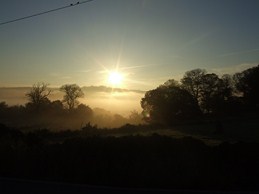 Psychoanalysis is about the functioning of the ‘Mind’. During this Camino I physically and mentally experienced that what we call a psychoanalytical process, is not merely restricted to the setting of a classical psychoanalysis. But I also realised that we need psychoanalytical knowledge and psychoanalysts in order to observe this and to act accordingly.
Psychoanalysis is about the functioning of the ‘Mind’. During this Camino I physically and mentally experienced that what we call a psychoanalytical process, is not merely restricted to the setting of a classical psychoanalysis. But I also realised that we need psychoanalytical knowledge and psychoanalysts in order to observe this and to act accordingly.



